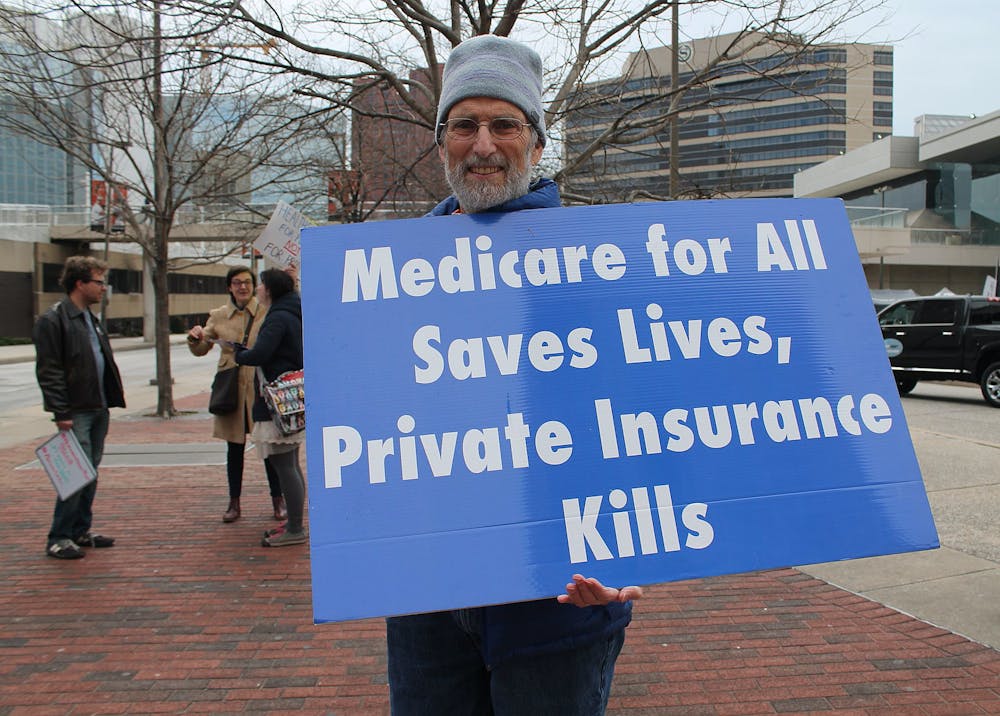Health care isn’t an iPhone. But moderate Democrats love to talk about health-care “choice” as if it is.
You might like to stay in the “Apple Ecosystem” when it comes to buying a new phone. But staying within the “MedStar Ecosystem” isn’t so fun when you’re having a heart attack.
The last thing on your mind is whether or not the hospital is “in-network.” And even if it is, your heart surgeon might not be. If you don’t like Apple, you can go with Samsung. But with health care, you have no other choices.
By law, emergency rooms can’t refuse patients. But what good is this if you walk out saddled with debt?
In 2017, over 28 million Americans were left uninsured. The number one cause of bankruptcy was medical debt. But with Senator Bernie Sanders’ “Medicare for All” plan, everyone would be insured and no one would go bankrupt due to medical expenses.
There are two types of insurance systems: multi-payer and single-payer. The former is when the private health insurance industry is kept intact. Proponents of this system hold up “choice” as the most important thing about health insurance.
The latter system is when the government is the “single” insurer. This is Medicare for All, which would do away with most private health insurance plans.
The remaining private insurers would not be able to offer what’s known as “duplicative care.” That is, they could not cover the same things that the government plan covers. They would, however, still be allowed to exist in a supplementary capacity, covering things like cosmetic surgery.
Sanders’ proposed plan would be generous, covering both vision and dental care, so private insurance would be largely unnecessary. But some might still wonder why it needs to be abolished.
Moderate Democrats would have you believe that a “public-option” is the best of both worlds. The logic goes that there would be a government plan for those who want it and private insurance for those who don’t. Before he dropped out, Pete Buttigieg even called his plan “Medicare-For-All-Who-Want-It.”
However, this system would be inadequate because it would still require you to “buy-in” with premiums. Since “choice” is so important, a multi-payer system would allow people to opt-out, thus defunding the public plan.
Private insurers would then cover those who were able to pay and leave those who were unable to pay on the government plan. So, a public-option would only have a fraction of the resources of Medicare-For-All, essentially setting it up to fail.
From there, it’s easy to imagine Republicans and moderate Democrats pointing to any government plan as being unfeasible and using it as a chance to cut public insurance entirely, thus leaving those same 28 million with no real “choice.”
Joe Biden supports an expansion of the Affordable Care Act (ACA), which would really just be a public option. But he should be wary of starting off with such a compromise. After all, the ACA was originally a Republican plan that Mitt Romney himself enacted in 2006 when he was the governor of Massachusetts.
Congressional Republicans’ subsequent obstructionism of the policy demonstrates that you can’t go to the bargaining table with a compromise. Even if Medicare for All cannot be passed in its strongest form, a public option isn’t what we should start with.
Then comes the question of “How do you pay for it?” Of course, to fund this program, taxes would need to go up slightly for the middle class and significantly for the top one percent of earners. But in reality, Medicare for All would eliminate the “private taxes” of premiums, copays and deductibles, meaning net costs would largely go down.
Budget hawks love to trot out the $47 trillion figure. But such a large number means little without context — namely that this plan will take effect over the course of 10 years.
According to a study by the Yale School of Public Health, if we maintain our current system, we will spend $52 trillion over that same time period. So we would spend $5 trillion more by not implementing Medicare for All.
Many other studies have also indicated that Sanders’ plan would save Americans money overall. A recent study in PLOS Medicine aggregated 22 economic analyses of Medicare for All, and found that studies “across the political spectrum estimated savings for single-payer.” And 86 percent actually predicted net savings within the first year.
As Diane Archer wrote in The Hill, “even the Mercatus Center, a right-wing think tank” found net savings with Sanders’ plan. By closing existing tax loopholes, eliminating individual health expenditures and ensuring the top one percent pay their fair share in taxes, health-care costs will go down.
With the topic of health care, most candidates fall back on empty platitudes like “choice” without specifying the implications of that choice.
Former candidates like Amy Klobuchar and Buttigieg had co-opted the progressive rhetoric of “universal coverage,” while subverting the main goals of Medicare for all. And they have now endorsed Joe Biden, hoping to prevent a Sanders nomination.
But free health care isn’t the existential threat they make it out to be. The “choice” that they espouse is merely an illusion to maintain the status quo.
Senator Bernie Sanders has fought against the status quo for decades. In 1991, he put it best when he said, “To the 1500 private insurance companies. Thank you. You’ve had your day. We can no longer afford to keep you.”
André Rush, Jr. is a senior Political Science major from Harford County, Md.

















